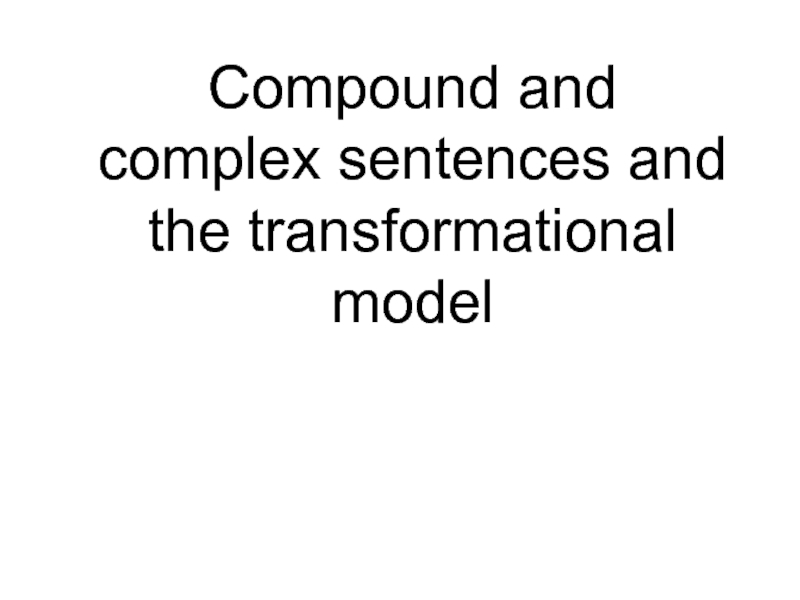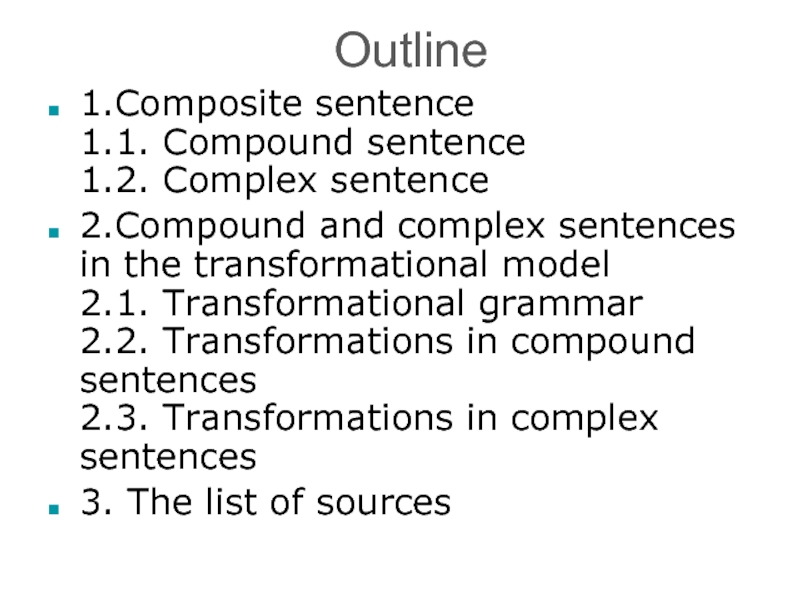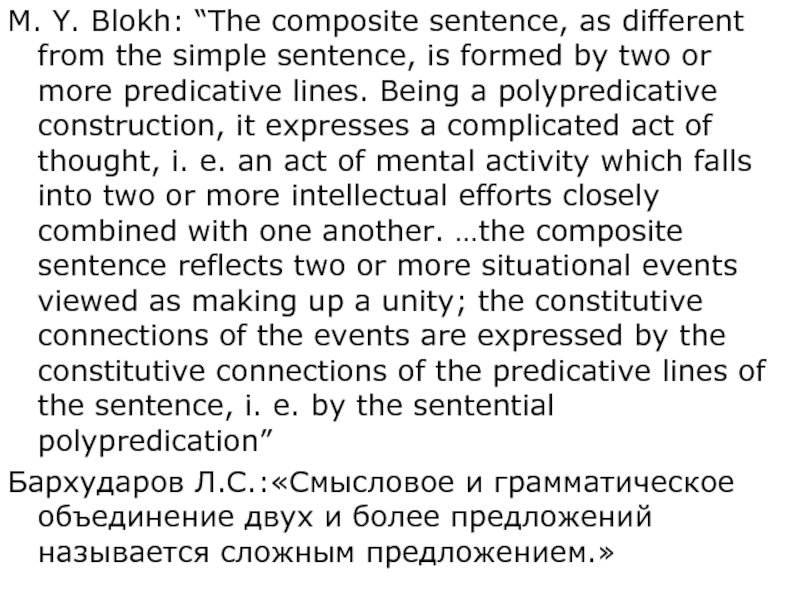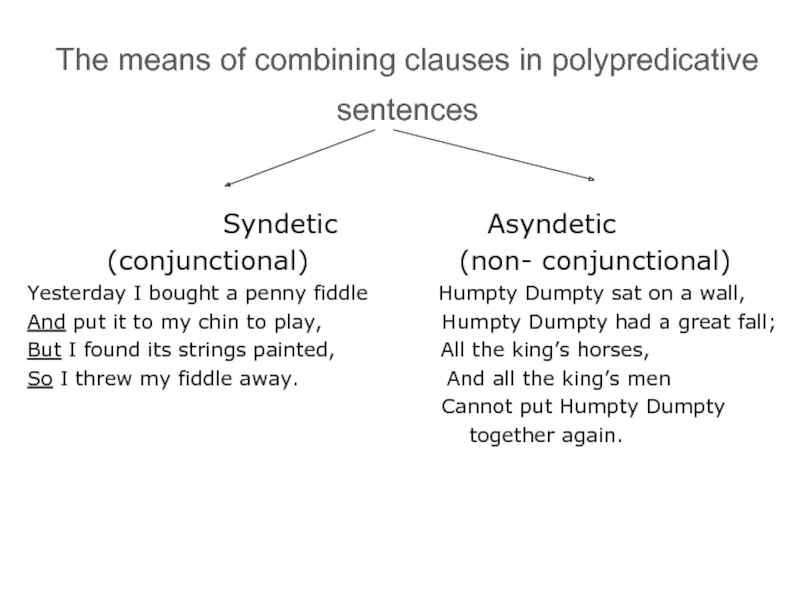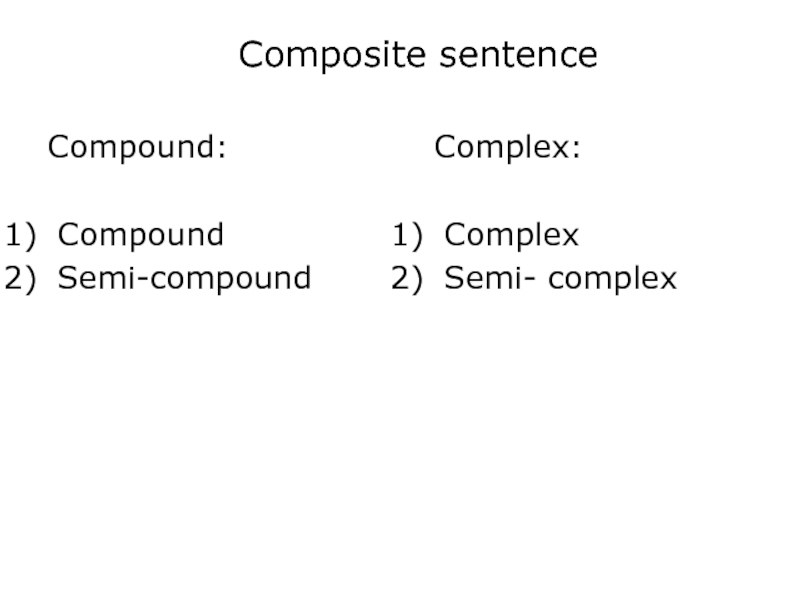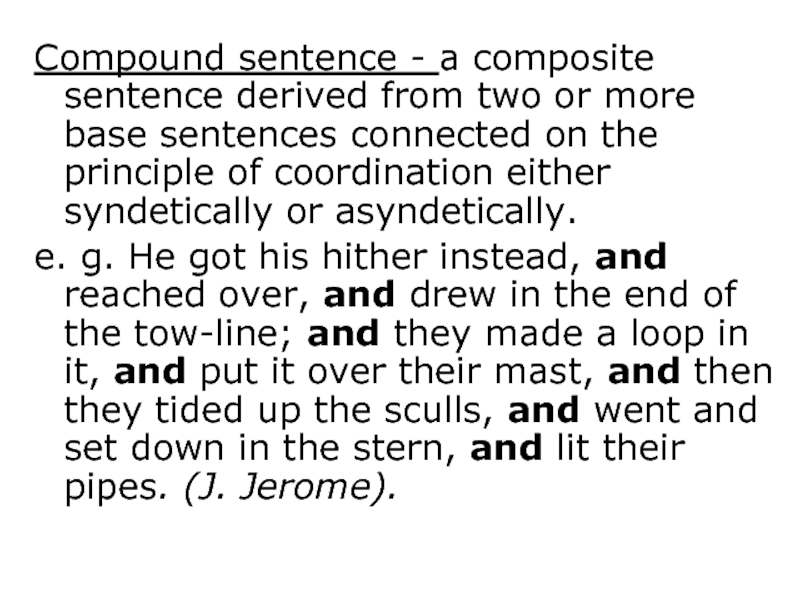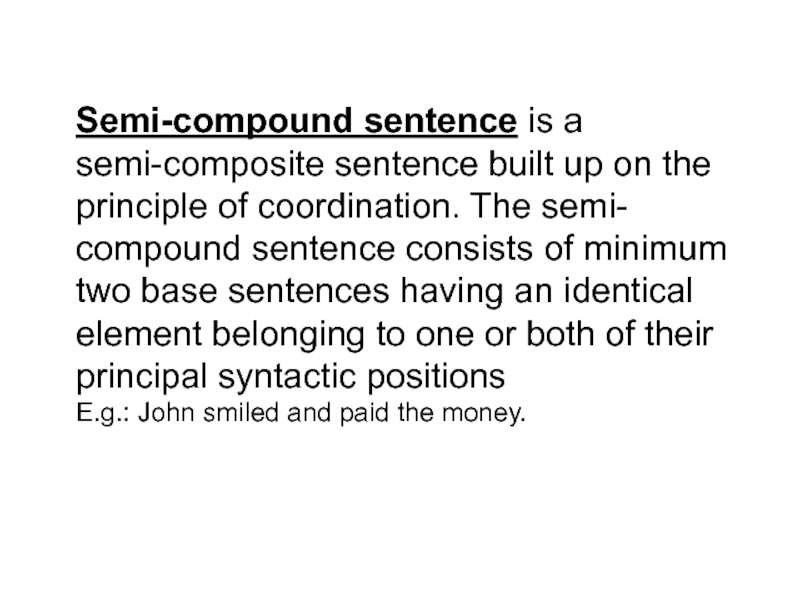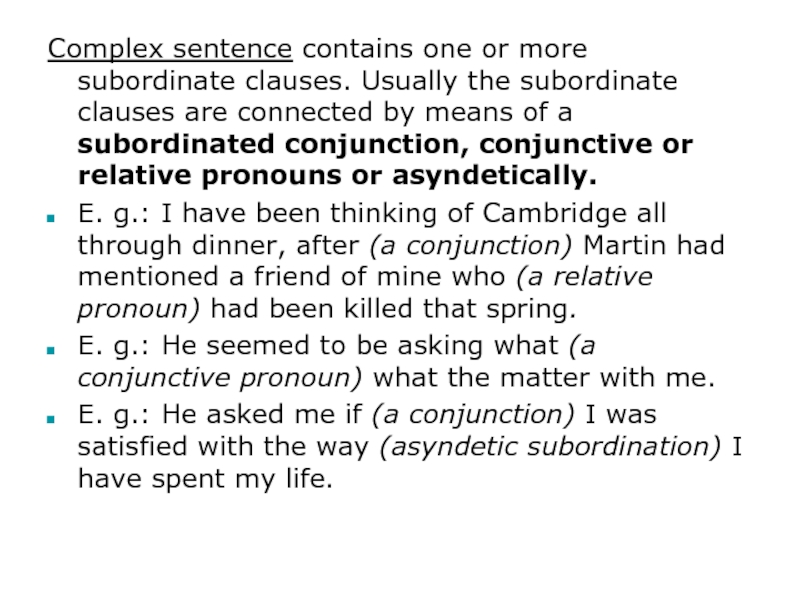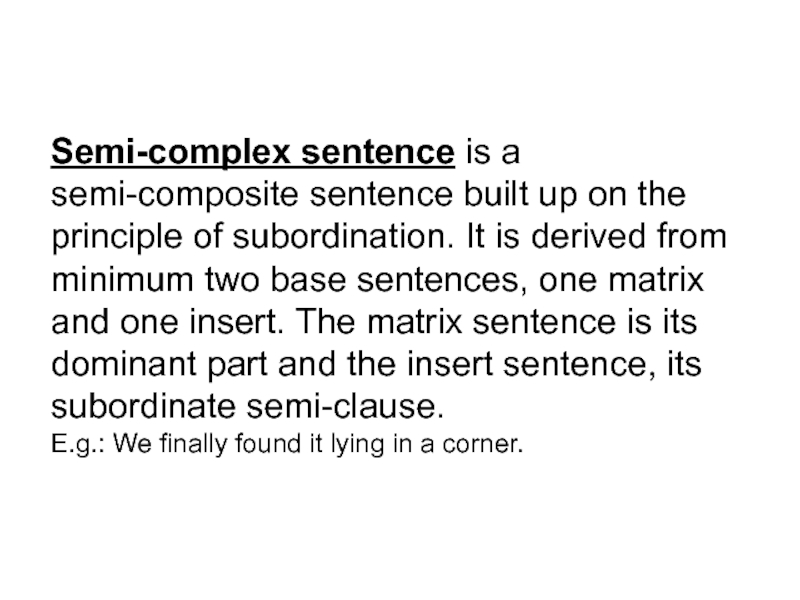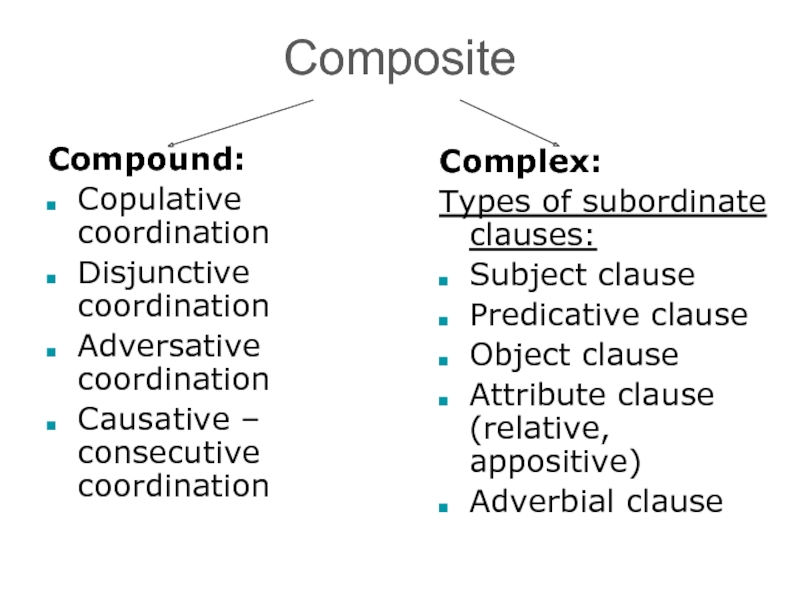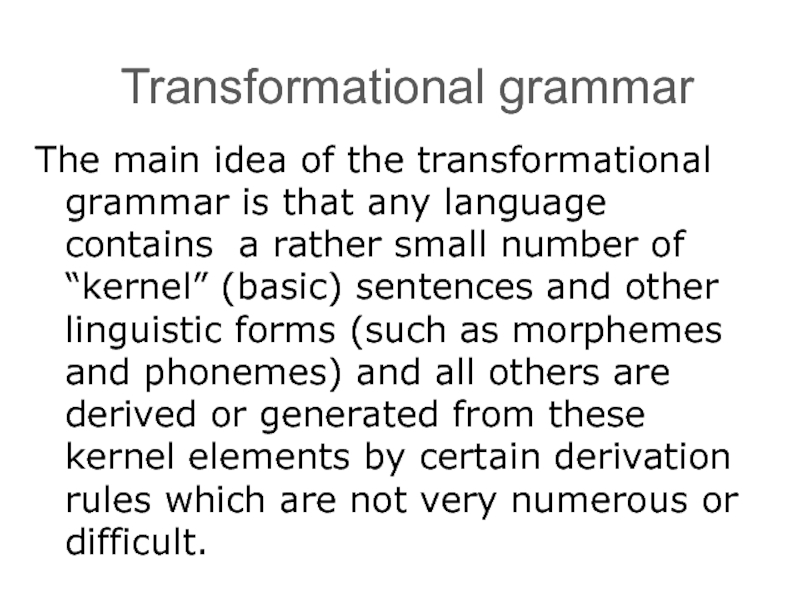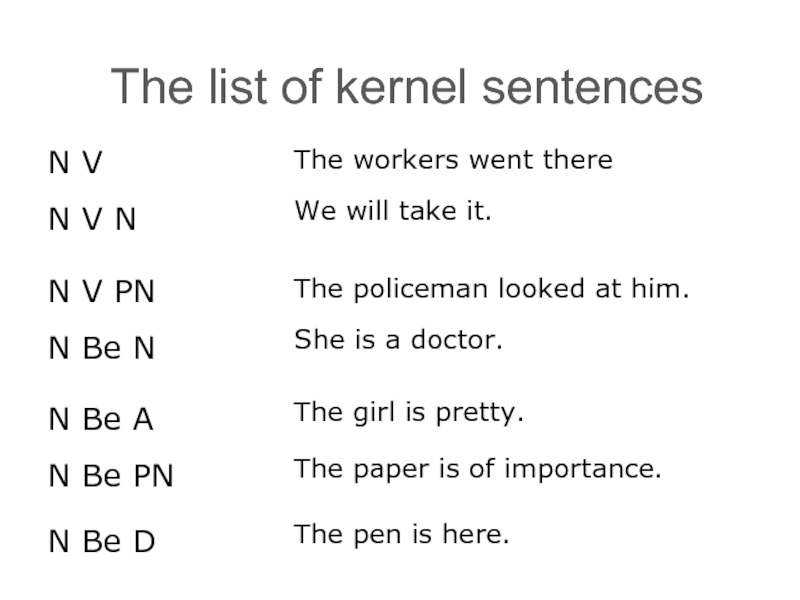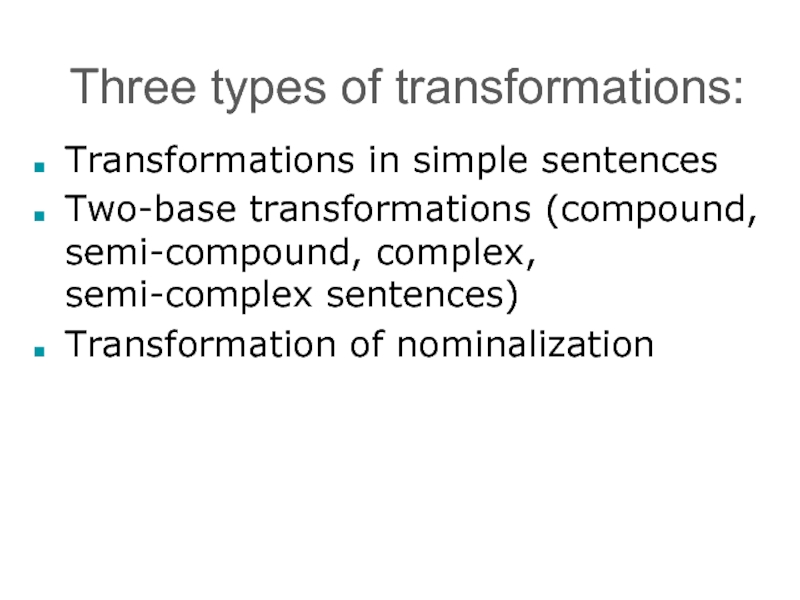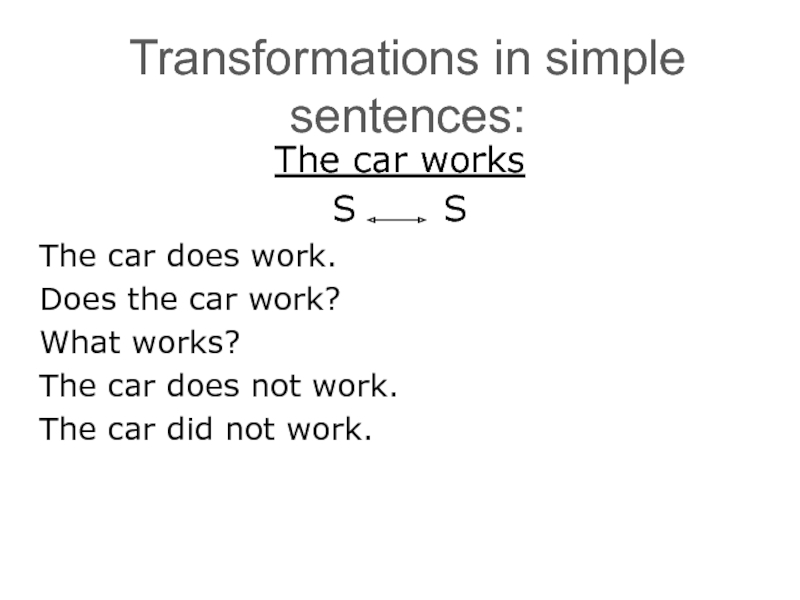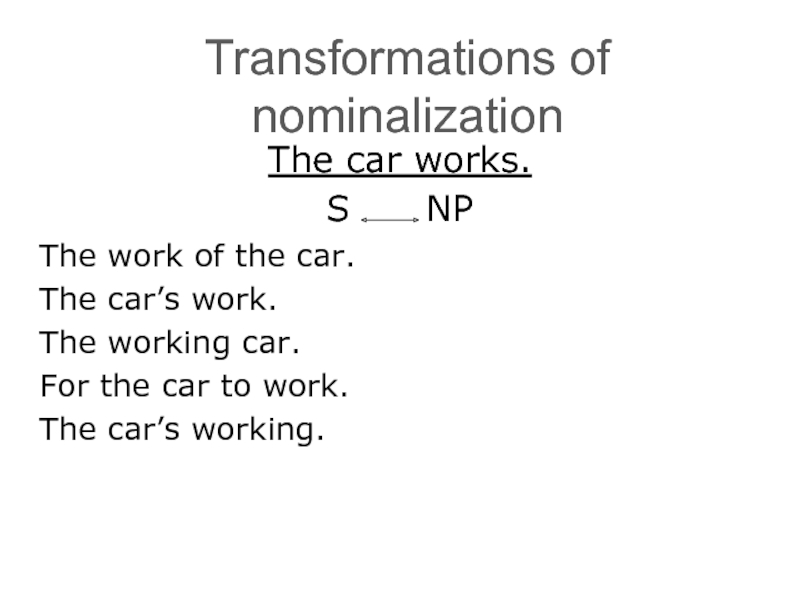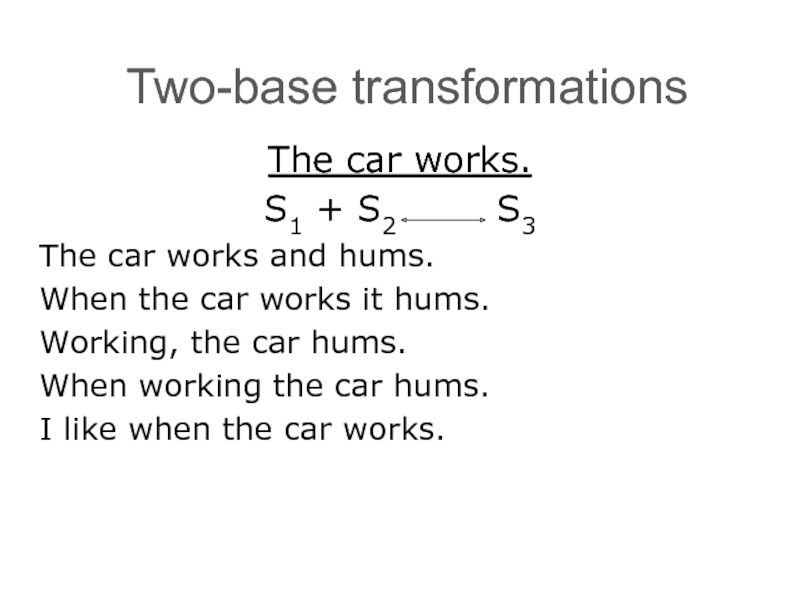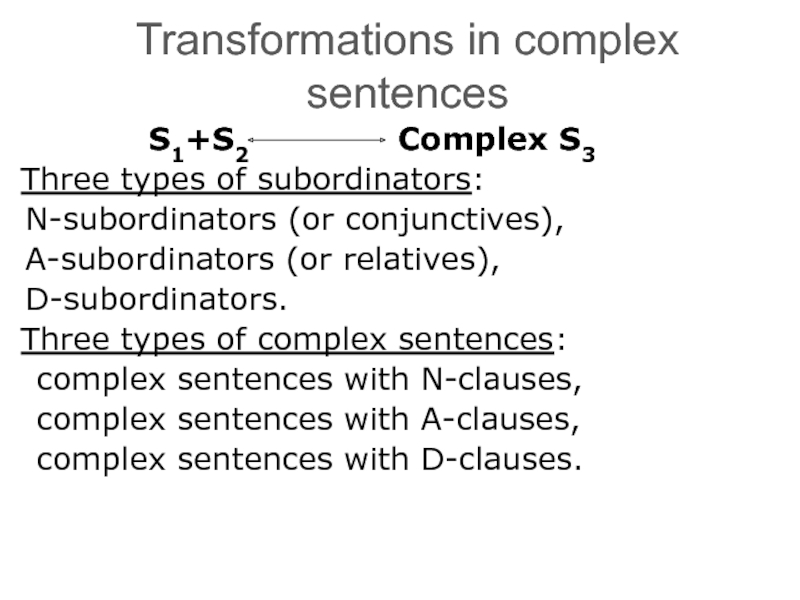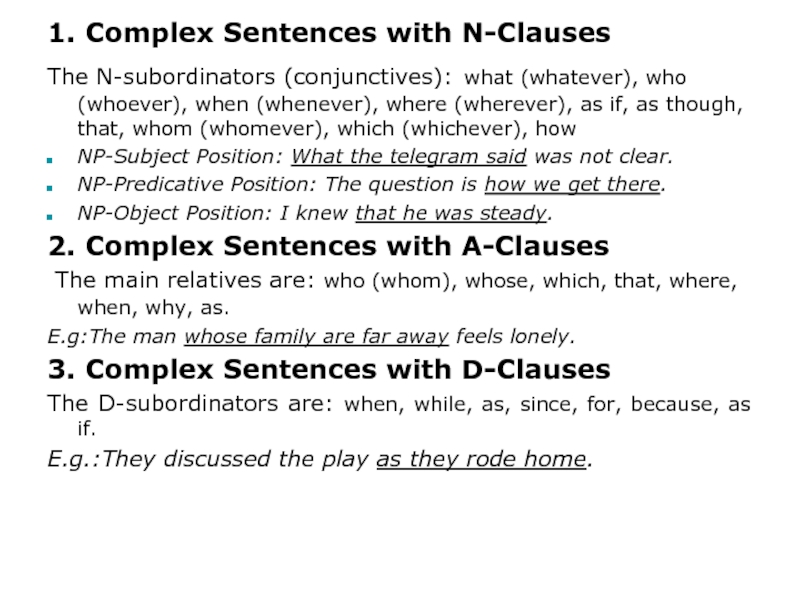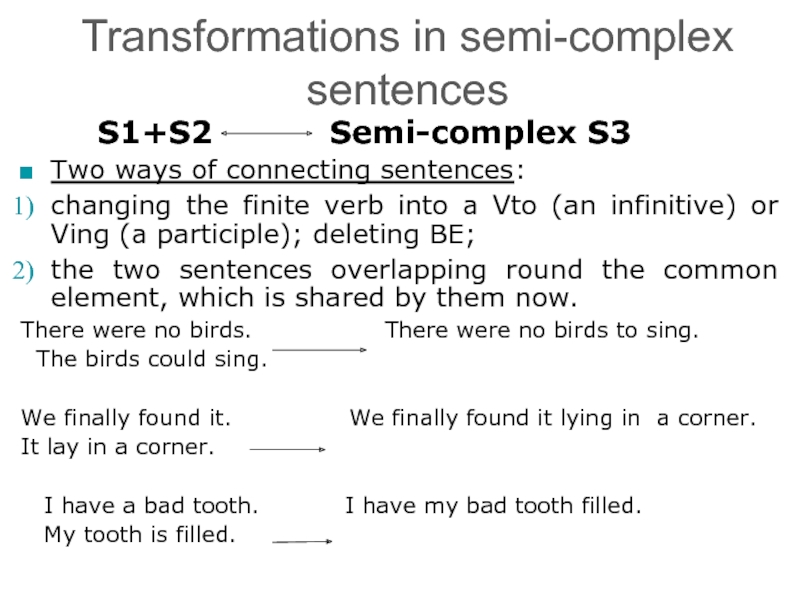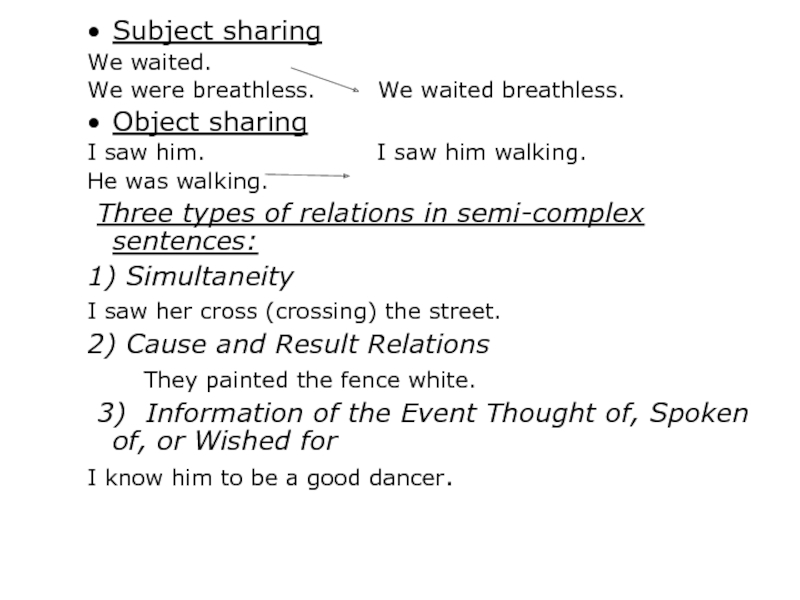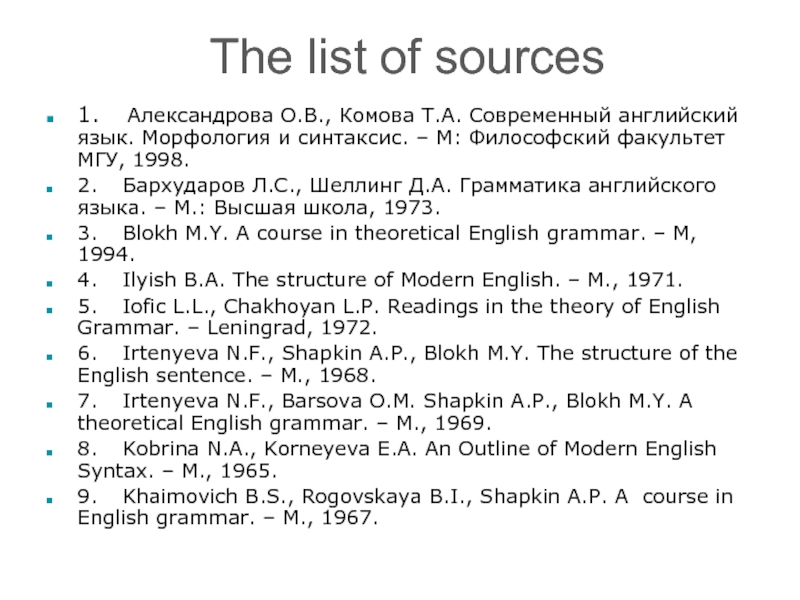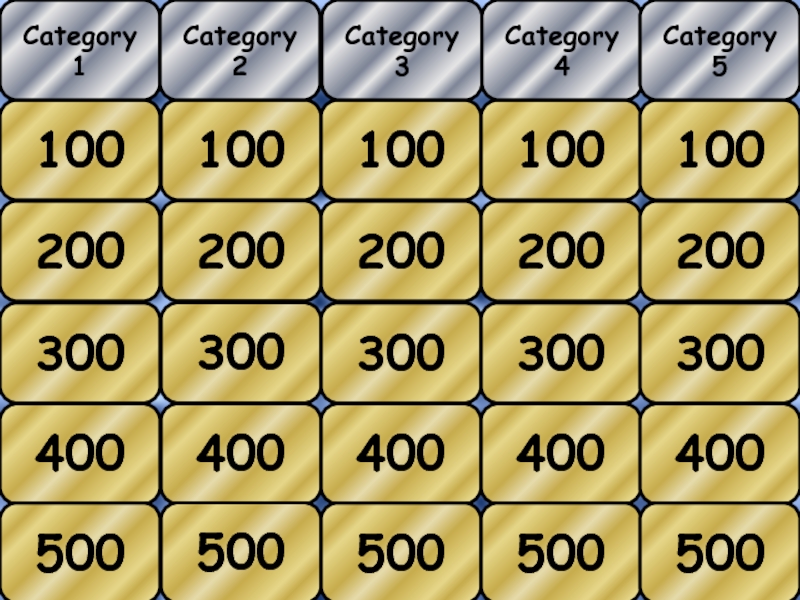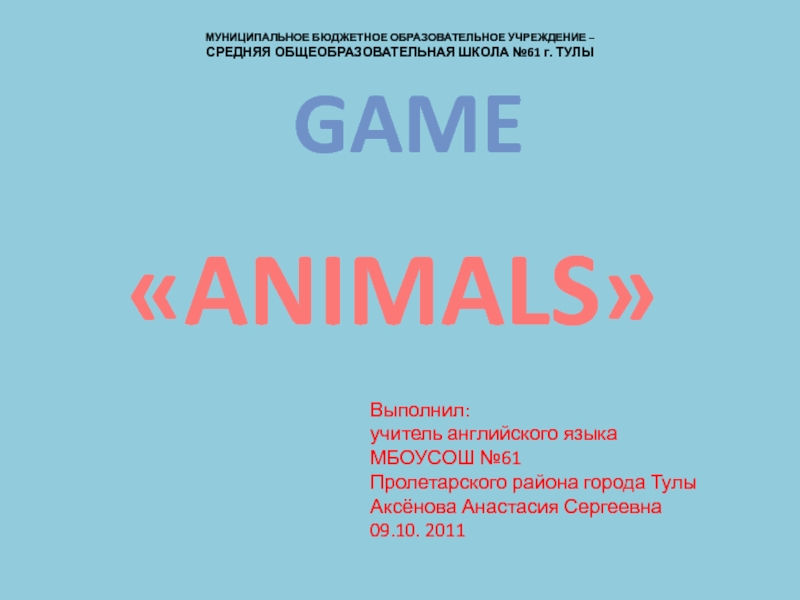- Главная
- Разное
- Дизайн
- Бизнес и предпринимательство
- Аналитика
- Образование
- Развлечения
- Красота и здоровье
- Финансы
- Государство
- Путешествия
- Спорт
- Недвижимость
- Армия
- Графика
- Культурология
- Еда и кулинария
- Лингвистика
- Английский язык
- Астрономия
- Алгебра
- Биология
- География
- Детские презентации
- Информатика
- История
- Литература
- Маркетинг
- Математика
- Медицина
- Менеджмент
- Музыка
- МХК
- Немецкий язык
- ОБЖ
- Обществознание
- Окружающий мир
- Педагогика
- Русский язык
- Технология
- Физика
- Философия
- Химия
- Шаблоны, картинки для презентаций
- Экология
- Экономика
- Юриспруденция
Compound and complex sentences and the transformational model презентация
Содержание
- 1. Compound and complex sentences and the transformational model
- 2. Outline 1.Composite sentence 1.1. Compound sentence 1.2.
- 3. M. Y. Blokh: “The composite sentence, as
- 4. The means of combining clauses in polypredicative
- 5. Composite sentences display two principal types of
- 6. Composite sentence
- 7. Compound sentence - a composite sentence derived
- 8. Semi-compound sentence is a semi-composite sentence built
- 9. Complex sentence contains one or more subordinate
- 10. Semi-complex sentence is a semi-composite sentence built
- 11. Composite Compound: Copulative coordination Disjunctive
- 12. Transformational grammar The main idea of the
- 13. The list of kernel sentences
- 14. Three types of transformations: Transformations in simple
- 15. Transformations in simple sentences: The car works
- 16. Transformations of nominalization The car works. S
- 17. Two-base transformations The car works. S1 +
- 18. Transformations in compound sentences
- 19. Transformations in semi-compound sentences S1+S2
- 20. Transformations in complex sentences
- 21. 1.
- 22. Transformations in semi-complex sentences
- 23. Subject sharing We waited. We were
- 24. The list of sources 1. Александрова О.В.,
- 25. 1.Complex sentence is built
- 26. 1.Subordination 2.Complex 3.Copulative – addition
Слайд 2Outline
1.Composite sentence
1.1. Compound sentence
1.2. Complex sentence
2.Compound and complex sentences in the
transformational model
2.1. Transformational grammar
2.2. Transformations in compound sentences
2.3. Transformations in complex sentences
3. The list of sources
3. The list of sources
Слайд 3M. Y. Blokh: “The composite sentence, as different from the simple
sentence, is formed by two or more predicative lines. Being a polypredicative construction, it expresses a complicated act of thought, i. e. an act of mental activity which falls into two or more intellectual efforts closely combined with one another. …the composite sentence reflects two or more situational events viewed as making up a unity; the constitutive connections of the events are expressed by the constitutive connections of the predicative lines of the sentence, i. e. by the sentential polypredication”
Бархударов Л.С.:«Смысловое и грамматическое объединение двух и более предложений называется сложным предложением.»
Бархударов Л.С.:«Смысловое и грамматическое объединение двух и более предложений называется сложным предложением.»
Слайд 4The means of combining clauses in polypredicative sentences
Syndetic
Asyndetic
(conjunctional) (non- conjunctional)
Yesterday I bought a penny fiddle Humpty Dumpty sat on a wall,
And put it to my chin to play, Humpty Dumpty had a great fall;
But I found its strings painted, All the king’s horses,
So I threw my fiddle away. And all the king’s men
Cannot put Humpty Dumpty
together again.
(conjunctional) (non- conjunctional)
Yesterday I bought a penny fiddle Humpty Dumpty sat on a wall,
And put it to my chin to play, Humpty Dumpty had a great fall;
But I found its strings painted, All the king’s horses,
So I threw my fiddle away. And all the king’s men
Cannot put Humpty Dumpty
together again.
Слайд 5Composite sentences display two principal types of construction
Subordination (inequality)
Coordination (equal rank)
Слайд 7Compound sentence - a composite sentence derived from two or more
base sentences connected on the principle of coordination either syndetically or asyndetically.
e. g. He got his hither instead, and reached over, and drew in the end of the tow-line; and they made a loop in it, and put it over their mast, and then they tided up the sculls, and went and set down in the stern, and lit their pipes. (J. Jerome).
e. g. He got his hither instead, and reached over, and drew in the end of the tow-line; and they made a loop in it, and put it over their mast, and then they tided up the sculls, and went and set down in the stern, and lit their pipes. (J. Jerome).
Слайд 8Semi-compound sentence is a semi-composite sentence built up on the principle
of coordination. The semi- compound sentence consists of minimum two base sentences having an identical element belonging to one or both of their principal syntactic positions
E.g.: John smiled and paid the money.
Слайд 9Complex sentence contains one or more subordinate clauses. Usually the subordinate
clauses are connected by means of a subordinated conjunction, conjunctive or relative pronouns or asyndetically.
E. g.: I have been thinking of Cambridge all through dinner, after (a conjunction) Martin had mentioned a friend of mine who (a relative pronoun) had been killed that spring.
E. g.: He seemed to be asking what (a conjunctive pronoun) what the matter with me.
E. g.: He asked me if (a conjunction) I was satisfied with the way (asyndetic subordination) I have spent my life.
E. g.: I have been thinking of Cambridge all through dinner, after (a conjunction) Martin had mentioned a friend of mine who (a relative pronoun) had been killed that spring.
E. g.: He seemed to be asking what (a conjunctive pronoun) what the matter with me.
E. g.: He asked me if (a conjunction) I was satisfied with the way (asyndetic subordination) I have spent my life.
Слайд 10Semi-complex sentence is a semi-composite sentence built up on the principle
of subordination. It is derived from minimum two base sentences, one matrix and one insert. The matrix sentence is its dominant part and the insert sentence, its subordinate semi-clause.
E.g.: We finally found it lying in a corner.
Слайд 11Composite
Compound:
Copulative coordination
Disjunctive coordination
Adversative coordination
Causative – consecutive coordination
Complex:
Types of subordinate
clauses:
Subject clause
Predicative clause
Object clause
Attribute clause (relative, appositive)
Adverbial clause
Subject clause
Predicative clause
Object clause
Attribute clause (relative, appositive)
Adverbial clause
Слайд 12Transformational grammar
The main idea of the transformational grammar is that any
language contains a rather small number of “kernel” (basic) sentences and other linguistic forms (such as morphemes and phonemes) and all others are derived or generated from these kernel elements by certain derivation rules which are not very numerous or difficult.
Слайд 14Three types of transformations:
Transformations in simple sentences
Two-base transformations (compound, semi-compound, complex,
semi-complex sentences)
Transformation of nominalization
Transformation of nominalization
Слайд 15Transformations in simple sentences:
The car works
S S
The car
does work.
Does the car work?
What works?
The car does not work.
The car did not work.
Does the car work?
What works?
The car does not work.
The car did not work.
Слайд 16Transformations of nominalization
The car works.
S NP
The work of the
car.
The car’s work.
The working car.
For the car to work.
The car’s working.
The car’s work.
The working car.
For the car to work.
The car’s working.
Слайд 17Two-base transformations
The car works.
S1 + S2 S3
The
car works and hums.
When the car works it hums.
Working, the car hums.
When working the car hums.
I like when the car works.
When the car works it hums.
Working, the car hums.
When working the car hums.
I like when the car works.
Слайд 18Transformations in compound sentences
S1 +S2 Compound S3
Two kernel sentences are joined together into a compound sentence by conjunction:
1.The man came to the window. The man came to
2.The detective saw him. the window, and
the detective saw him.
The connection can involve substitution, permutation:
1. We asked for his slides.
2. He showed us his slides.
The result is: We asked for his slides, and he showed them to us.
The connection can involve substitution of an identical V and addition of ‘so’ and ‘neither’:
I shall make a fair copy of the dictation.
He will make a fair copy of the dictation.
The result: I shall make a fair copy of the dictation and so will he.
The connection can involve deletion:
He rushed to the door, she to the window.
Two kernel sentences are joined together into a compound sentence by conjunction:
1.The man came to the window. The man came to
2.The detective saw him. the window, and
the detective saw him.
The connection can involve substitution, permutation:
1. We asked for his slides.
2. He showed us his slides.
The result is: We asked for his slides, and he showed them to us.
The connection can involve substitution of an identical V and addition of ‘so’ and ‘neither’:
I shall make a fair copy of the dictation.
He will make a fair copy of the dictation.
The result: I shall make a fair copy of the dictation and so will he.
The connection can involve deletion:
He rushed to the door, she to the window.
Слайд 19Transformations in semi-compound sentences
S1+S2 Semi-compound S3
1. Overlapping
round the identical NP-subject
1. I must go.
2. I must put the car away. I must go and put the caraway.
2. Overlapping round the identical verb
1. Brenda laughed.
2. John laughed. Brenda and John laughed.
3. Overlapping round both the identical NP-subjects and the identical verbs.
1. Doris felt helpless.
2. Doris felt angry. Doris felt helpless and
angry.
1. I must go.
2. I must put the car away. I must go and put the caraway.
2. Overlapping round the identical verb
1. Brenda laughed.
2. John laughed. Brenda and John laughed.
3. Overlapping round both the identical NP-subjects and the identical verbs.
1. Doris felt helpless.
2. Doris felt angry. Doris felt helpless and
angry.
Слайд 20Transformations in complex sentences
S1+S2
Complex S3
Three types of subordinators:
N-subordinators (or conjunctives),
A-subordinators (or relatives),
D-subordinators.
Three types of complex sentences:
complex sentences with N-clauses,
complex sentences with A-clauses,
complex sentences with D-clauses.
Three types of subordinators:
N-subordinators (or conjunctives),
A-subordinators (or relatives),
D-subordinators.
Three types of complex sentences:
complex sentences with N-clauses,
complex sentences with A-clauses,
complex sentences with D-clauses.
Слайд 21
1. Complex Sentences with N-Clauses
The N-subordinators
(conjunctives): what (whatever), who (whoever), when (whenever), where (wherever), as if, as though, that, whom (whomever), which (whichever), how
NP-Subject Position: What the telegram said was not clear.
NP-Predicative Position: The question is how we get there.
NP-Object Position: I knew that he was steady.
2. Complex Sentences with A-Clauses
The main relatives are: who (whom), whose, which, that, where, when, why, as.
E.g:The man whose family are far away feels lonely.
3. Complex Sentences with D-Clauses
The D-subordinators are: when, while, as, since, for, because, as if.
E.g.:They discussed the play as they rode home.
NP-Subject Position: What the telegram said was not clear.
NP-Predicative Position: The question is how we get there.
NP-Object Position: I knew that he was steady.
2. Complex Sentences with A-Clauses
The main relatives are: who (whom), whose, which, that, where, when, why, as.
E.g:The man whose family are far away feels lonely.
3. Complex Sentences with D-Clauses
The D-subordinators are: when, while, as, since, for, because, as if.
E.g.:They discussed the play as they rode home.
Слайд 22Transformations in semi-complex sentences
S1+S2
Semi-complex S3
Two ways of connecting sentences:
changing the finite verb into a Vto (an infinitive) or Ving (a participle); deleting BE;
the two sentences overlapping round the common element, which is shared by them now.
There were no birds. There were no birds to sing.
The birds could sing.
We finally found it. We finally found it lying in a corner.
It lay in a corner.
I have a bad tooth. I have my bad tooth filled.
My tooth is filled.
Two ways of connecting sentences:
changing the finite verb into a Vto (an infinitive) or Ving (a participle); deleting BE;
the two sentences overlapping round the common element, which is shared by them now.
There were no birds. There were no birds to sing.
The birds could sing.
We finally found it. We finally found it lying in a corner.
It lay in a corner.
I have a bad tooth. I have my bad tooth filled.
My tooth is filled.
Слайд 23Subject sharing
We waited.
We were breathless. We waited
breathless.
Object sharing
I saw him. I saw him walking.
He was walking.
Three types of relations in semi-complex sentences:
1) Simultaneity
I saw her cross (crossing) the street.
2) Cause and Result Relations
They painted the fence white.
3) Information of the Event Thought of, Spoken of, or Wished for
I know him to be a good dancer.
Object sharing
I saw him. I saw him walking.
He was walking.
Three types of relations in semi-complex sentences:
1) Simultaneity
I saw her cross (crossing) the street.
2) Cause and Result Relations
They painted the fence white.
3) Information of the Event Thought of, Spoken of, or Wished for
I know him to be a good dancer.
Слайд 24The list of sources
1. Александрова О.В., Комова Т.А. Современный английский язык.
Морфология и синтаксис. – М: Философский факультет МГУ, 1998.
2. Бархударов Л.С., Шеллинг Д.А. Грамматика английского языка. – М.: Высшая школа, 1973.
3. Blokh M.Y. A course in theoretical English grammar. – M, 1994.
4. Ilyish B.A. The structure of Modern English. – M., 1971.
5. Iofic L.L., Chakhoyan L.P. Readings in the theory of English Grammar. – Leningrad, 1972.
6. Irtenyeva N.F., Shapkin A.P., Blokh M.Y. The structure of the English sentence. – M., 1968.
7. Irtenyeva N.F., Barsova O.M. Shapkin A.P., Blokh M.Y. A theoretical English grammar. – M., 1969.
8. Kobrina N.A., Korneyeva E.A. An Outline of Modern English Syntax. – M., 1965.
9. Khaimovich B.S., Rogovskaya B.I., Shapkin A.P. A course in English grammar. – M., 1967.
2. Бархударов Л.С., Шеллинг Д.А. Грамматика английского языка. – М.: Высшая школа, 1973.
3. Blokh M.Y. A course in theoretical English grammar. – M, 1994.
4. Ilyish B.A. The structure of Modern English. – M., 1971.
5. Iofic L.L., Chakhoyan L.P. Readings in the theory of English Grammar. – Leningrad, 1972.
6. Irtenyeva N.F., Shapkin A.P., Blokh M.Y. The structure of the English sentence. – M., 1968.
7. Irtenyeva N.F., Barsova O.M. Shapkin A.P., Blokh M.Y. A theoretical English grammar. – M., 1969.
8. Kobrina N.A., Korneyeva E.A. An Outline of Modern English Syntax. – M., 1965.
9. Khaimovich B.S., Rogovskaya B.I., Shapkin A.P. A course in English grammar. – M., 1967.
Слайд 25 1.Complex sentence is built on the principle of
…
a) subordination
b) coordination
c) other
2.The following conjunctions when, who, where are typical for:
a) complex
b) compound
c) composite
3.Match the type of connection between the clauses in compound sentences and their meanings
Copulative Cause and consequence
Disjunctive Addition
Adversative Choice
Causative-consecutive Result
Resultative Contrast
4. How many kernel sentences are given in transformational grammar?
5. Match the sentences with their symbolic representation:
N V She is a doctor.
N VN The workers went there.
N VPN The girl is pretty.
N BE N We will take it.
N BE A The policeman looked at him.
N BE PN The pen is here.
N BE D The paper is of importance
Copulative Cause and consequence
Disjunctive Addition
Adversative Choice
Causative-consecutive Result
Resultative Contrast
4. How many kernel sentences are given in transformational grammar?
5. Match the sentences with their symbolic representation:
N V She is a doctor.
N VN The workers went there.
N VPN The girl is pretty.
N BE N We will take it.
N BE A The policeman looked at him.
N BE PN The pen is here.
N BE D The paper is of importance
Слайд 261.Subordination
2.Complex
3.Copulative – addition
Disjunctive – choice
Adversative – contrast
Causative – consecutive- cause, consequence
Resultative - result
4. 7
5. The workers went there (N V)
We will take it ( N V N)
The policeman looked at him ( N V PN)
She is a doctor(N BE N)
The girl is pretty (N BE A )
The paper is of importance ( N BE P N)
The pen is here ( N BE D)
Resultative - result
4. 7
5. The workers went there (N V)
We will take it ( N V N)
The policeman looked at him ( N V PN)
She is a doctor(N BE N)
The girl is pretty (N BE A )
The paper is of importance ( N BE P N)
The pen is here ( N BE D)
